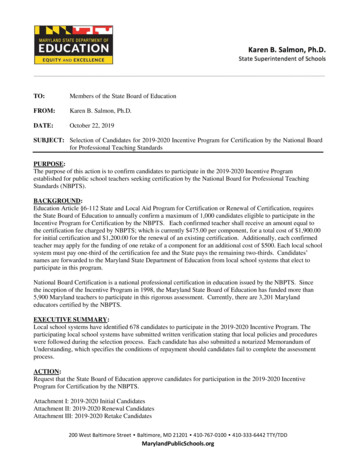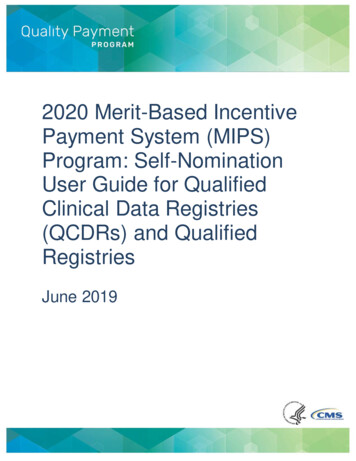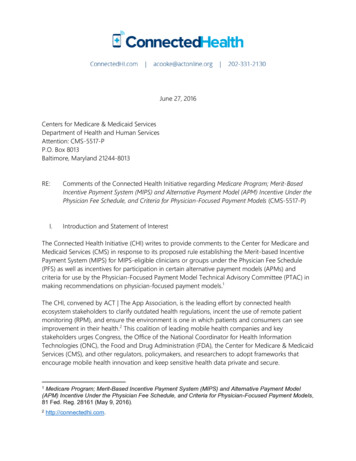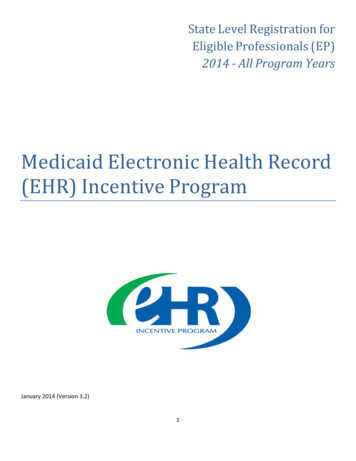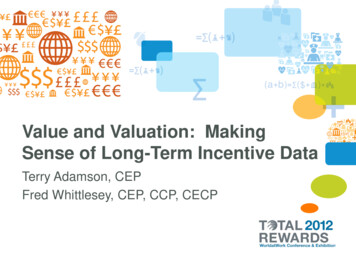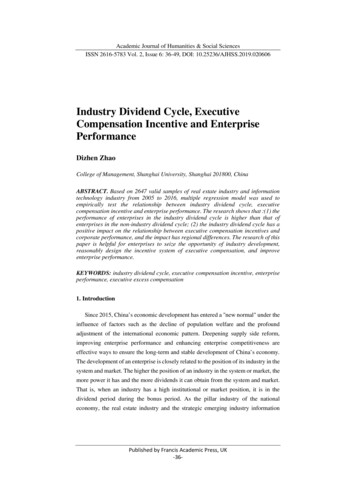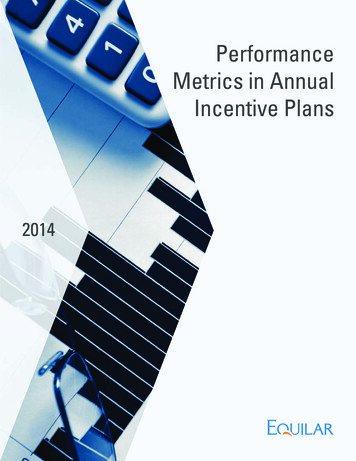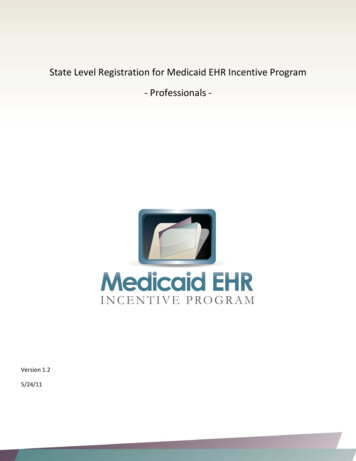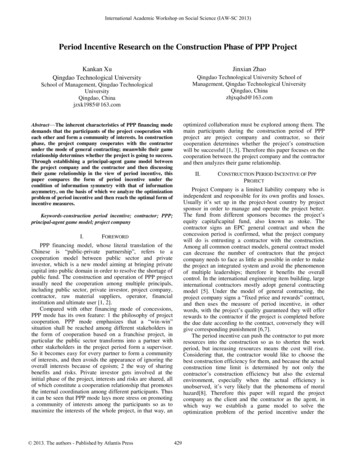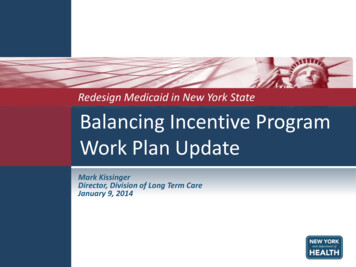
Transcription
Redesign Medicaid in New York StateBalancing Incentive ProgramWork Plan UpdateMark KissingerDirector, Division of Long Term CareJanuary 9, 2014-.
Balancing Incentive ProgramBackgroundThe Balancing Incentive Program (BIP) is a funding opportunity offeredunder section 10202 of the Affordable Care Act: Provides enhanced FMAP ( 2%) to participating states to rebalanceMedicaid Long Term Services and Supports (LTSS) by increasingaccess and expanding community services as an alternative toinstitutional care. Requires 3 structural changes:1 No Wrong Door/Single Entry Point network (NWD/SEP) Core Standardized Assessment Instruments Conflict Free Case Management
Balancing Incentive ProgramOverviewBIP involves: rebalancing the delivery of long term services and supports(LTSS) towards community-based care; promoting enhanced consumer choice; standardizing information for eligibility determination andenrollment processes; improving access to and expanding community LTSS; and providing essential services in the least restrictive setting.2
Balancing Incentive ProgramOverview The BIP period is April 1, 2013 – September 30, 2015. The State must make progress toward identified targets in thestructural requirements and rebalancing goals to maintainadditional aid. When BIP ends, the State must show an increase in thecommunity-based LTSS percentage from the baselinepercentage by the end of the BIP period.3
Balancing Incentive ProgramStructural Change 1No Wrong Door/Single Entry Point (NWD/SEP) Network: Consistent information must be delivered about LTSS options whether anindividual seeks information from a 1-800 number, a website, or a localoffice that is part of the state’s NWD/SEP network. Provides assistance in enrolling the individual in services. The State plans to:4 expand NY Connects statewide; add an interactive web-based screening tool to allow individuals to help identifytheir LTSS needs; and develop tools and training to ensure consistent information about the LTSSavailable in communities across New York.
Balancing Incentive ProgramGoals of NWD/SEPGoals/Targets: Standardize information so that all individuals experience the same eligibility determinationand enrollment process. State has a network of NWD/SEPs and an Operating Agency; DOH is the Oversight Agency. NWD/SEPs have access points where individuals can inquire about community LTSS andreceive comprehensive information, community LTSS program options counseling, andenrollment assistance. The NWD/SEP system includes an informative community LTSS website and a 1-800 number. State advertises the NWD/SEP system to help establish it as the “go to system” forcommunity LTSS.5
Balancing Incentive ProgramNWD/SEPCurrent Status:6 Inter-agency Work Group meets bi-weekly (DOH, SOFA, OMH,OPWDD, OASAS). The approved BIP application identified the need to expand andenhance NY Connects both functionally and geographically. Work Group is developing the system to expand and enhance the NYConnects structure across populations and the state. Initial overview of the system is in final stages of design. List of potential NWD/SEPs has been provided to CMS.
Balancing Incentive ProgramNWD/SEPChallenges/Next Steps:7 An RFP for the system Technical Detail Specifications is indevelopment. State will need to promote NWD/SEP as the “go to system” orgateway to information about community-based LTSS.
Balancing Incentive ProgramNWD/SEPChallenges/Next Steps continued:8 Agencies becoming part of the NY Connects network will need totransform their business model to conform with operationalstandards. Agencies will have to learn new systems in order to provide generalinformation and be accessible across “all populations.” Agencies will need to have staff trained on the new system, enhancedfunctions, and the interpretation of screening results.
Balancing Incentive ProgramStructural Change 2Core Standardized Assessment (CSA): Identifies the support needs and information on serviceplanning and is used across the state and across a givenpopulation. Must meet the Core Data Set (CDS) requirements outlined inBIP guidance. Leverages the Uniform Assessment System (UAS-NY). The assessment is completed by a qualified professional.9
Balancing Incentive ProgramCore Standardized Assessment /Core Data Set (CDS)Goals/Targets:10 Develop a Level I screen with a minimal number of questions toindicate eligibility for Medicaid-funded community LTSS. Leverage implementation of NY’s Uniform Assessment System (UASNY) to expand across populations (Intellectually Disabled(ID)/Developmentally Disabled (DD), Mental Health/BehavioralHealth(MH/BH) and fulfill the required domains - topics of CMS’s CDSfor the Level II assessment. Train qualified professionals and NWD/SEP members to initiate andcoordinate the collection of Level II assessments utilizing existing webbased courses.
Balancing Incentive ProgramCSA/CDSCurrent Status:11 The State has submitted to CMS a crosswalk of assessment toolscurrently in use that includes all required domains and topics withinthe specified CDS. DOH is currently implementing UAS-NY using the interRAI suite toolsfor the aged and disabled population. OPWDD is developing a population specific assessment for the I/DDpopulation that utilizes many of the same assessment elements. OMH has selected the interRAI Community Mental HealthAssessment for the adult population and CANS-NY for children.
Balancing Incentive ProgramCSA/CDSChallenges/Next Steps:12 Automation is complex, time consuming and requires IT expertise. Timing of implementation across agencies differs.
Balancing Incentive ProgramStructural Change 3Conflict Free Case Management (CFCM) optimally involves: Separation of case management from direct services provision. The case manager’s responsibilityis to develop a plan of supports and services based on the individual’s assessed needs. Separation of clinical eligibility determination and care planning assessment from direct servicesprovision. Eligibility is determined by an entity or organization that has no fiscal relationship to theindividual.When overlaps do occur, an effective CFCM system mitigates these conflicts through: Independent evaluation. A person who is related (through blood or marriage) to the individual orto any paid caregiver of the individual, or who serves as the individual’s financial or healthrepresentative may not perform evaluations or assessments or develop plans of care for theindividual. Establishment of firewalls and appropriate safeguards. Monitoring and state oversight assuresconsumer choice and protects consumer rights.13
Balancing Incentive ProgramConflict Free Case ManagementGoals/Targets:14 Identify areas of possible conflict and existing mitigation strategies incase management. Establish protocol to remove/mitigate conflict in community LTSSeligibility determination/enrollment, case management processes andservice delivery. Develop an independent process to assure that person-centered plansmeet the needs of individuals served in community-based settings.
Balancing Incentive ProgramConflict Free Case ManagementCurrent Status: The state has submitted to CMS a description of potential conflicts that mayexist across programs and agencies as well as strategies currently in place tomitigate risks.Challenges/Next Steps:15 CFCM within a managed care environment – a common problem for manystates implementing BIP. Decide how to remove or mitigate conflict – may require organizationalchange, process change, state oversight or administrative firewalls. Clarify the scope of the CFCM requirements internally across agencies andprograms.
Balancing Incentive ProgramUse of BIP Funds Statute: (c)(4) USE OF ADDITIONAL FUNDS.—The State agrees touse the additional Federal funds paid to the State as a result of thissection only for purposes of providing new or expanded offerings ofnon-institutionally-based long-term services and supports describedin subsection (f)(1)(B) under the State Medicaid program.What can BIP funds be used for: BIP funds can be used for: Increased offerings of, or access to, noninstitutional LTSS which benefit Medicaid recipients. BIP funds are subject to the same prohibitions as Medicaid funds:Cannot be used to match other Federal Funds, or to supplant, etc.16
Balancing Incentive ProgramCMS InterpretationCMS has developed a three-part test to help States assess whether the use ofenhanced FMAP meets legislative requirements. If a State can answer “Yes”to all three of the following questions, the proposed use of funds isacceptable.17 Does the proposal increase offerings of or access to non-institutionalLTSS? Does the proposed expansion/enhancement of offerings/accessbenefit Medicaid recipients? Is the proposal something that Medicaid funds can typically be spenton (i.e. the proposal does not involve a prohibited use of Medicaidfunding)?
Balancing Incentive ProgramFunding Plan for Rebalancing This master Funding Plan is a dynamic and fluid tool designed to: Change according to identified need,Encourage providers to serve people within the community, andCreate opportunity for Stakeholder involvement. 598.7 million has been allocated to address the following identified gaps inareas of community-based LTSS: Insufficient Community Capacity,Insufficient Financial Incentives for Community Placement,Inefficient Infrastructure, andInadequate Administrative Resources.Note: Some funding items are pending CMS approval.(BIP Funds cannot be used for institution or capital expenditures).18
Balancing Incentive ProgramFunding PlanGoals/Targets:19 Expand availability of community-based residential, support and day serviceoptions for populations transitioning from institutional settings (i.e., ID/DDindividuals impacted by the closure of developmental centers). Create 24/7 direct Crisis Stabilization Teams for the Mental Health populationtransitioning to supportive housing. Provide additional housing supports and services for those transitioning out ofSkilled Nursing Facilities (SNF), Psychiatric Centers or adult homes. Implement Community First Choice Option to streamline services and increaseaccess to Home and Community Based Services. Incentivize providers to consolidate and reduce administrative functions.
Balancing Incentive ProgramFunding PlanGoals/Targets:20 Develop standardized screen for determining eligibility for community LTSS. Enhance reimbursements for supported employment and day programs(pending CMS approval). Enhance PACE in non-urban areas (pending CMS approval). RFA for Innovations Demonstration project to think differently and create newsolutions (pending CMS approval).
Balancing Incentive ProgramSustainability RequirementGoals/Targets: Develop clear estimates of the cost to maintain structural changes implementedthrough BIP funding sources.Current Status: All funding sources to implement BIP structural changes have been identifed. The utilization of the enhanced funding has been detailed in the BIP funding plan.Challenges/Next Steps: 21The development of a comprehensive sustainability plan to maintain theimplemented structural changes.
Balancing Incentive ProgramData Collection and ReportingThree Types of Data Are Required:1.Service Data – State must report the percent of fundsspent on community-based LTSS from claims andother data sources.2.Quality Data – State must report its collection anddissemination of quality data and outcome measures.3.Outcome Measures – State must evaluate beneficiaryand caregiver satisfaction.22
Balancing Incentive ProgramData Collecting and ReportingCMS Requirements: States must report service, outcome and quality measure data toCMS.Current Status: An Interagency Work Group is creating a catalog of quality tools andsurveys. A Data Collection Protocol has been identified for semi-annualreporting to CMS.Challenges: 23Uniformity of data measures across programs and agencies.
Balancing Incentive ProgramHousing (State Specific)Goals/Targets:24 Housing requirements set forth in the BIP work plan byCMS are specific to New York State. These work plan requirements relate to the Individualswith Intellectual and Developmental Disabilities (I/DD)populations and are also included in the “transformationagreement.” The BIP funding plan supports these housing requirementsand also provides additional funds for housing supportsand services across all populations served by Medicaid.
Balancing Incentive ProgramBIP Housing (State Specific)Current Status: Strategies for building housing options for the I/DD populationstransitioning to community settings have been developed and areincluded in the BIP work plan. BIP funding for assistance across populations is not prescribed; sothere is opportunity for stakeholders to be involved in developing thespecifics.Challenges/Next Steps: 25Creation and implementation of alternative settings depends onvarying regional capacity and composition.
Balancing Incentive Program andthe OPWDD Transformation The OPWDD Transformation agreement is a long-term planwith strategies to move to a person-directed system that isprimarily community-based. BIP is a CMS challenge to states to provide the most costeffective community-based services, care and supports in theleast restrictive non-institutional setting. Through BIP, CMS is providing the State with an enhancedFMAP to expand, enhance and make structural changes to itscommunity-based service delivery system.26
Balancing Incentive Program andthe OPWDD Transformation Together, OPWDD and DOH are pursuing policies andopportunities for individuals with disabilities to receiveservices and care in the least restrictive, community-basedsettings. The BIP funding allows New York to move forward on OPWDDtransformation efforts, and where initiatives are included inboth the BIP work plan and the OPWDD TransformationAgenda, staff are working cross-agency to assurecoordination.27
Balancing Incentive Program andMFP Common Goals The Balancing Incentive Program and Money Follows thePerson Demonstration: Share a rebalancing goal; Provide enhanced funding which compliment the programrequirements: 28MFP funding can be used for the implementation of broader infrastructuredevelopments such as “no wrong door” access to care systems; Are designed to work together and across populations; Are challenged by moving into MLTC environments.
Balancing Incentive ProgramNext Steps and Challenges Biggest challenge may be Conflict Free Case Management.BIP funding will be used, in part, to assure sufficient plans andprovider options in less populated counties and for moredifficult-to-serve members to attract additionalplans/providers and enhance consumer choice. Agencies becoming part of the NY Connects network will needto change to adhere to new operational standards. Items pending CMS Approval, may require the State toeliminate identified action items and/or create new actionitems. Time frame to spend funds.29
Contact Us:Resources:E-mail: BIP@health.state.ny.usURL for the manual: www.balancingincentiveprogram.orgMRT website:http://www.health.ny.gov/health care/medicaid/redesign/Subscribe to our listserv:http://www.health.ny.gov/health care/medicaid/redesign/listserv.htm‘Like’ the MRT on Facebook: http://www.facebook.com/NewYorkMRTFollow the MRT on Twitter: @NewYorkMRT30
Jan 09, 2014 · the OPWDD Transformation The OPWDD Transformation agreement is a long-term plan with strategies to move to a person-directed system that is primarily community-based. BIP is a CMS challenge to states to provide the most cost-effective community-based services, care and supports in the least restrictive non-institutional setting.
